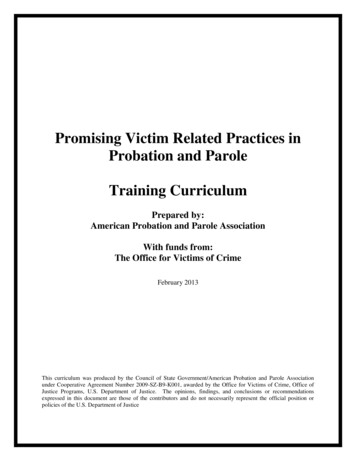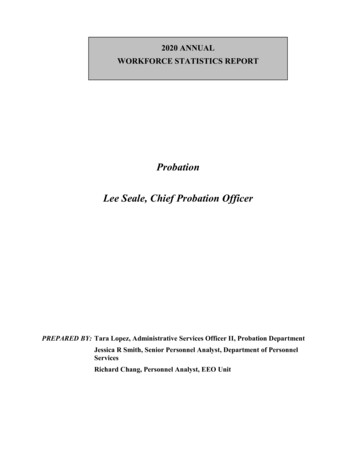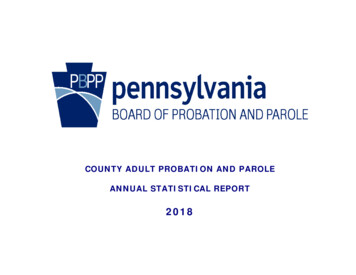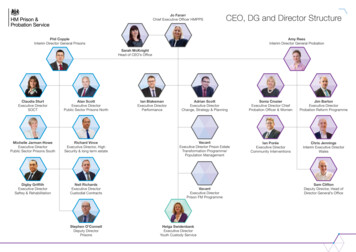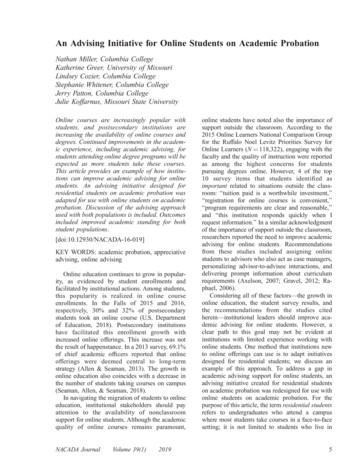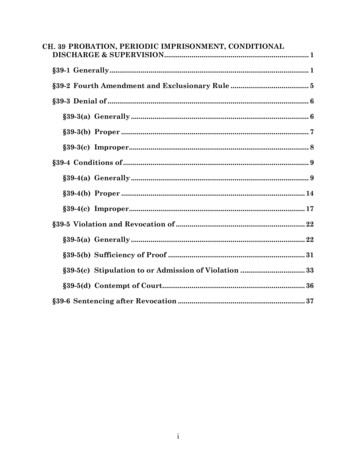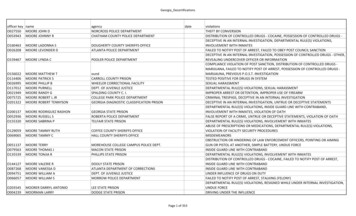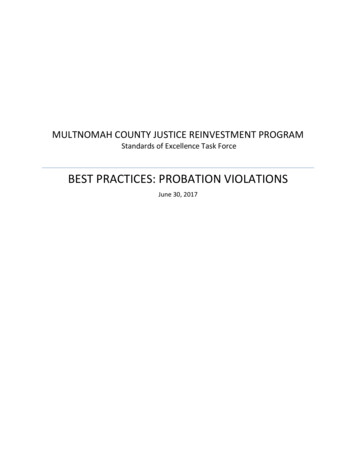
Transcription
MULTNOMAH COUNTY JUSTICE REINVESTMENT PROGRAMStandards of Excellence Task ForceBEST PRACTICES: PROBATION VIOLATIONSJune 30, 2017
Task Force MembersJudgesJudge Stephen K. Bushong, ChairJudge Ed JonesDeputy District AttorneysDavid HannonRyan LufkinDefense AttorneysJon MartzShelley KellerProbation OfficersJoelle Smykowski, DCJAmy Kane, DCJTreatment ConsultantTim Hartnett, CODAStaffJoel Bruhn, OJDApril Mazur, MPDLily Yamamoto, LPSCCBest Practices at Probation Violations Hearings – Probation Officers . 2Best Practices at Probation Violation Hearings - Defense Attorneys . 6Best Practices at Probation Violation Hearings-District Attorneys . 10Best Practices at Probation Violation Hearings--Judges . 14APPENDIX . 191
Best Practices at Probation Violations Hearings – Probation OfficersI.PV Arraignments/JC2GOAL: To provide as much information as possible regarding alleged violations to DAsand defense lawyers as quickly as possible so they can adequately prepare forhearings. If client is brought into custody on an outstanding warrant, order reports anddetermine if there are any additional violations to allege. When detaining clients after police contact, be sure to compose a detaileddetainer. Violations in the detainer should include additional information. Forexample:o Failure to obey all laws: include pending charges, date, and availableinformation.o Failure to report-date client last reported.o Failure to report address- last home visit date, attempt to complete home visitor date letter sent. Detainers returning to court should include “hold for hearing” and the followingadditional information when applicable:o Recommending revocation.o Available sanctioning units have been exhausted.o MCJRP case- No administrative sanctions.o Recommending a sanction outside the grid that only the court can impose.o Refusing the administrative sanction.2
o Case expired or is past expiration date (this is being considered for a change bythe court).II.Preparation Order police reports if applicable. Contact DDA for assistance when needed. Allege all possible violations and forward written report to supervisor three daysprior to hearing. If revocation is not being recommended, order any assessments needed fortreatment referrals prior to hearing when applicable. Prepare file and electronic chronological log for hearing. Notify DDA of witnesses and contact information as soon as possible in anticipationof a contested hearing. Verify the hearing date and time prior to the scheduled date. Attempt to attend all scheduled hearings in person. If coverage is needed, updatethe PO covering the hearing on all pertinent information to the case.III.Determining appropriate recommendation How does the recommendation serve public safety, short and long term? How does the recommendation address the offender’s criminogenic risk factors? Consider what law/sentencing guidelines/department policy allows. What is the least restrictive sanction to the desired outcome? What are you hoping to accomplish: removing the offender from the communityfor as long as possible, get the offender’s “attention”, develop long-termtreatment or program plan?3
Will alternative sanctions, such as community service, electronic monitoring,change center etc., be as effective as jail? What alternative sanctions have eitherbeen used or considered? Is the recommended sanction available to the offender? Is treatment, housing,electronic monitoring etc., available, and is the offender an appropriate referral? Does the recommendation follow logically from the violations and conformancesection? Make sure there are custody units available if you are recommending jail as asanction. If to address the needs of a victim, are there plans in place for the victim and is theavailable remaining custody time adequate in light of that plan. What would bethe impact of the recommendation on the interest of existing victims? Address each case in the recommendation, even if you are asking for no action ona particular case.IV.PV Hearing Appear on time and in person for scheduled hearing. Be prepared to discuss all alleged violations, conformance, and substantiation forrecommendation being made. If applicable, give reporting instructions. Have client sign any needed releases of information for referrals if applicable. Avoid editorializing and unprofessional opinions. Be objective and include only thefacts while describing behavior. Express professional opinions about how best to achieve the required objective,but avoid unprofessional judgments while making a persuasive argument insupport of an opinion. If the point is that repeated efforts haven’t worked, makethat point. If the point is that the offender represents a continuing danger to4
specific persons or the community, make that point. Useful opinions are thosebased on the facts, the literature, and experience undistorted by frustration.V.Post Hearing Document the hearing and outcome in chrono notes. If revoked, indicate in chrononotes that the client will not be returned to MCJRP caseload upon release fromcustody, and close file. Make any appropriate or court ordered referrals. Schedule releases with jail when applicable.5
Best Practices at Probation Violation Hearings - Defense AttorneysI. Prior to the HearingA. Reviewing the File Contact JA. Determine if date and time set at arraignment is available for both thecourt and attorney. Verify that hearing will happen within 14 days of arrest and/ordetainer. ORS 137.545(6). (JA will then contact PO and DA Control if time ofhearing is changed. JA will order transport). Have staff interview client as soon as possible. Determine if client knows whatviolation might be alleged. Get basic contact information and what they haveaccomplished on probation. Review court records. Determine if probation is still viable (i.e. court still hasjurisdiction over the probation); conviction date, charge and grid, prior PV’s (pullold files or download previous judgments). If M57, determine what thepresumptive prison sentence would be. If the probation is a downward, departure,determine if a natural or stipulated grid. Note: if a departure from Measure 11, ifthe proved violation is a new criminal conviction, the court MUST revoke theprobation. ORS 137.712(5). Verify probation department has not alreadysanctioned client for the same conduct on this probation. (ORS 137.593(3). Review custody status. Does client have any holds, warrants, other pending cases(open or probations) in this or any other jurisdiction? Get PO report. If haven’t received report three days before hearing time, contactPO via phone or email to get report or its status. Review report. Can the state prove the allegations? What State witnesses are needed/available? Did client admit violations to PO? (Was client in custody? Miranda?Attorney appointed?) Does client agree probation was violated? What witnesses/evidence does client want to present. Is it practicable toget witnesses/evidence before scheduled hearing time, need ROI, etc.? CanPO verify information without need to request the records? Review recommendation.6
Is the court likely to follow the recommendation? Determine alternative to recommendation. Is it a legal recommendation? Determine maximum sanction units perguidelines, verify previously used sanction units. Is the sanction beingrecommended within the guideline range? If revocation recommendation,is PO asking for consecutive terms? Must have more than one violation ofprobation. (OAR 213-012-0040). Is the term of PPS appropriate to the grid? Is the allegation a new law violation? Did it get no complainted/indicted?What are the next dates? If in Multnomah, contact attorney on that case.Notify attorney of pending PV hearing and if appropriate set PV to track withnew case. Periodically remind other attorney that PV should be negotiatedwith new charges.B. Consult with client Does client agree with the violation? If not, can the state prove it? Does client agree with the recommendation? Discuss possible outcomes with client. Always remind client, even if POrecommending continuation of probation, that judge can revoke and what themaximum sentence could be. Discuss viability of what client wants to happen. If client wants to presentevidence, determine if it can be obtained before set hearing date. If not, discussclient waiving right to a hearing within 14 days. If client is willing to waive, contactJA about moving hearing. Verify that court is willing to take attorney’srepresentation of waiver (most do, some require written waiver). Consider using Motivational Interviewing techniques. If client disagrees with recommendation, consider contacting PO to exploreoptions: START Mental Health Court Veteran’s Court Inpatient treatment GPS/SCRAM7
II. Attend the Hearing Prior to client’s arrival, consider discussing with PO/DDA the recommendationsand goals of the probation, and how to accomplish these goals. Considerproposing an in chamber discussion to make Court aware of potential issues. Indicate if client will stipulate to violation, or is requesting a contested hearing. Contested Hearings: Be Aware of the followingoooooooMust be provided with written notice of the allegations, State v. Eckley, 34Or App 563 (1978).Standard of proof: preponderance of the evidence, State v. Fortier, 20 OrApp 613 (1975).Exclusionary Rule Applies: St ex rel Juv Mult Co v. Rogers, 314 Or 114 (1992).Hearsay: rules of evidence do not apply, but constitutional right ofconfrontation means you can object to hearsay. See State v. Harris, 260 OrApp 154 (2013)(lab tech), State v. Monk, 244 Or App 152 (2011)(PO testifyingto contents of police report – reversed), State v. Terry, 240 Or App 330 (2011)(PO testifying that defendant to an office who told the PO – reversed), Statev. Wibbens, 238 Or App 737 (2010)(PO testifying that officer told himdefendant smelled of alcohol – reversed).Right to testify, call witnesses: Gagnon v. Scarpeli, 411 US 778 (1973).Collateral Estoppel may apply to the state. State v. McAllister, 72 Or App 611(1985)(this is the reason the state seldom proceeds on a PV allegation whenthere is a pending charge based on the same facts).PO’s generally cannot impose conditions of probation except as provided forunder ORS 137.540(8) for crimes committed on or after August 1, 2013 withwritten notice to the court and DA’s office. PO may characterize addedconditions of probation as “abide by PO directive.” Clients can challengeconditions of probation not judicially imposed, State v. Maack, 270 Or App400 (2015). Present client’s position to the court. If probation is continued, PO may ask for additional conditions of probation. Thoseprobation conditions need to be reasonably related to the crime of conviction. ORS137.540(2). There is quite a bit of case law on this, sometimes striking, sometimesaffirming. Here are a few of the most recent cases: State v. Bell, 276 Or App 218
(2016), State v. Hurita, 276 Or App 58 (2016), State v. Gallo, 275 Or App 868 (2015),State v. Gaskill, 250 Or App 100 (2012), State v. Olson, 246 Or App 785 (2011). Fill out and file Notice and Advise of Right to AppealIII. Post HearingAfter hearing follow up with client requests to call family, obtain Releases ofInformation, etc.9
Best Practices at Probation Violation Hearings-District AttorneysI. PV Arraignments / JC2 Review files in coordination with probation officer attending JC2 for PV allegations. Ensure probation reports (if available) are placed in the file. If the only allegation is a new law violation that has not yet been adjudicated, consult withJC2 PO or case PO about whether any other violations have occurred that could be addedto an amended report. After the PV arraignments are complete for the day, the contested PV cases will beassigned to a DDA as soon as possible to the Unit responsible for the prosecution. Assigned case DDA (Sr. DDA will distribute if unassigned) will be responsible for preppingthe case for the PV hearing.II. Preparation Assess victim rights issues and obtain victim input (if any). DDA should review CRIMES notes for assigned PV file as soon as they learn of the PVassignment. Review prior history of the case, number of PVs, and OECI record of prior sanctions. Contact PO and discuss case even if report is not yet ready. If the only allegation is a new law violation that has not yet been adjudicated, consult withPO about whether there are other violations that could be added to an amended report. Assess the strength of the violations and what proof would be required to substantiatethem. Determine whether defendant made any admissions to PO concerning the allegations. Determine whether proof of one or more allegations are sufficient to obtain theappropriate level of sanctioning and whether it is warranted to forgo more difficult toprove allegations.10
Begin to assess whether revocation or continuation of probation is warranted (offenderaccountability, intent of parties in negotiations, victim safety, community safety,likelihood of recidivism, number and quality of prior sanctions, prior recommendationsby DDAs, previous judicial statements etc.) Generate subpoenas for necessary witnesses. For substantive hearsay that may be admissible, examine case law and determinewhether a showing can be made that the hearsay should be admitted. Email or call the assigned defense attorney to inform them of your assignment to the caseand request information concerning which allegations are to be contested or stipulatedat the hearing. Negotiate PV if appropriate. Consider victim rights issues and ensure victim has been notified of the hearing.III. PV Hearing Discuss the PV allegations with the defense attorney. Determine which allegations arestipulated and which are contested. If the victim wishes to participate in the hearing, then consult with the victim beforenegotiating any probation violation resolution. Negotiate PV outcome if appropriate. Discuss strengths and weaknesses of probationer’s compliance with supervisionconditions. Discuss the appropriate case plan if continued on probation. (What tools are left to try?What increases likelihood of success by continuation?) Discuss revocation and whether the purposes of probation are being served. Determine which allegations the State will seek to prove, whether continuances will berequested on any allegations and the defendant’s 14 day custody status.11
Do not request a continuance past the 14th day without proving/stipulating at least oneallegation unless absolutely necessary. Determine whether revocation or continuation is appropriate given the allegations thatcan (or will) be proved. Factors weighing in favor of revocation include but are not limited to: seriousness ofunderlying conduct, negotiation intent of the parties settling the case, prior sanctioninghistory, low likelihood of rehabilitation, prior statements of the court expressing intent torevoke, lengthy or egregious criminal history of offender, prior recommendations of DA’sto revoke, offender accountability, victim input aligns with revocation, severity ofviolations, exhaustion of sanctioning authority etc. Factors weighing against revocation include but are not limited to: PO/defense present astrong case plan for future success, lesser sanctions have not been tried and/or foundineffective, victim input aligns with probation continuance, mitigation presented by POor defense, offender showing success in other areas of probation, work/family/housinghistory and other pro-social strengths, accountability shown by offender concerning theviolations, etc. If revocation is contemplated, advocate for an appropriate revocation sentence based onthe following considerations: the underlying facts of the case, seriousness of theviolations, danger to the community, need to incapacitate defendant from tyandpossiblereformation/rehabilitation issues within prison. For allegations of new law violations that have not yet been adjudicated, determinewhether any other allegations – unrelated to the new law violation – have occurred andseek either a stipulation or to prove those violations. For allegations of new law violations that have not yet been adjudicated, considerwhether ultimate sanctioning should be left until after adjudication has occurred and, ifappropriate, request the court hold defendant in custody on other proven/stipulatedallegations until adjudication occurs. When calling case, inform the court whether the hearing is to be contested and whetherthe parties have reached any stipulations.12
If seeking a continuance for any allegation(s) inform court and explain rationale and effectof any 14-day issues for the request. Present evidence on each allegation sought to be proved, including sworn testimony ofPO. Ensure any admissions of defendant are presented in evidence. If sufficient evidence has been presented, argue in favor of a finding of violation. If the victim wishes to participate in the probation violation hearing, inform the Court andoffer the victim the opportunity to share with the Court the victim’s input on thedisposition. Present recommendation to court for appropriate sanction and explain the rationale forthe recommendation.IV. Post Hearing If the victim participated in the hearing, explain what happened at the hearing and assistthe victim with any questions they have with the case. Update the vi ctim’s contact information for future notifications and provide thatinformation to the probation officer. Write detailed notes concerning the PV allegations, and document which allegations werestipulated, proved, dismissed or continued. Write detailed notes concerning the hearing itself and any statements by the offenderwhich show amenability to, or opposition of, future supervision efforts. Document the State’s recommendation and the Court’s actual sanction imposed. Document any judicial statements concerning expectations, likelihood of revocation ifjudicial order is not followed, or other similar thoughts for future PV hearings. Summarize log note in CRIMES for electronic record keeping.13
Best Practices at Probation Violation Hearings--JudgesI.PV Hearings—In General Judges may have distinct roles in a PV hearing. The judge must be a neutral adjudicator,consistently following the law and applying fair procedures in deciding whether theprobationer is in violation, whether revocation is warranted, and what sanction should beimposed. However, if probation is continued, the judge’s role may be different. A PVhearing provides an opportunity for a judge to help the probationer get back on track andavoid further violations. Remember that POs have limited resources and difficult jobs. Judges should use POs asa resource, without disparaging their efforts or attempting to micromanage their work. Under ORS 137.545(6), a probationer must be released from custody if the hearing is notheld within 14 days of the probationer’s arrest except for good cause shown. Under Article I, section 42 of the Oregon Constitution, crime victims have a right to bepresent at any critical stage of the proceedings. The DA’s office has a process for notifyingvictims of their rights. Ask the DA if the victim has requested an opportunity to be heardat the PV hearing.A. Determining Whether Probationer is in Violation If probationer stipulates to one or more violations and you are satisfied that theprobationer understands that he/she has a right to a contested hearing and wants towaive that right, accept the stipulation and proceed to sanction stage. Consider reviewingthe probationer’s rights with the probationer before accepting the stipulation. If probationer does not stipulate and the parties are ready to proceed to a contested PVhearing, conduct the hearing and make appropriate findings. Judges should strive tofollow applicable procedures and legal requirements consistently so that procedures andoutcomes do not vary depending on which judge is conducting the hearing. If necessary, address any evidentiary issues, such as the extent to which hearsay evidencewill be offered at the hearing. See State v. Harris, 260 Or App 154 (2016); State v.Wibbens, 238 Or App 737 (2010).14
Avoid rescheduling PV hearings for a date earlier than the date scheduled at arraignment;that can cause problems for other participants. Encourage communication among DAs,defense counsel and POs regarding scheduling and the scope and necessity of a PVhearing. If the parties are not ready for a contested hearing, set over the PV hearing ifappropriate.B. Determining the Appropriate Sanction Review the PO’s report and recommended sanction; review the LS/CMI and the originalassessment report. POs should be prepared to discuss the probationer’s conformance onprobation, what strategies have been attempted, what worked, what didn’t work, andwhat plan might best address the probationer’s needs in ways that will minimize the riskof recidivism. Consider modifying/adding to conditions of probation if appropriate. If thePO is recommending revocation, discuss reasons for that recommendation. Determine what the DA’s recommendation is and why. If the DA is recommendingrevocation, the DA should be prepared to explain why probation with MCJRP conditionswill not work. If the DA is recommending continuing on probation, the DA shouldrecommend an appropriate sanction and participate in the discussion of what plan mightbest address the probationer’s needs in ways that will minimize the risk of recidivism andensure victim safety. Obtain input from the defense attorney. If the State is recommending revocation,consider defense arguments for continuing probation. If the court is satisfied thatcontinuing probation is the best option, consider recommendations from defenseattorney regarding sanction and any modification of terms and conditions of probation. Determine whether the probationer has other pending cases or open probations,including cases in other jurisdictions. Consider the effect a sanction in this case will haveon other cases, and vice versa. Obtain input, if any, from victim.II.Revocation Sanctions Stipulated sanctions: if the parties previously stipulated to a particular sanction ifprobation is revoked, the court should impose the agreed-upon prison sanction absentgood reasons to deviate from the agreement. If defendant stipulated to a higher gridblock and a revocation sentence based on that grid block as part of the plea agreement,15
the state expects the court to hold the parties to their agreement. Judges should notdeviate from the agreement unless there are good reasons to do so. Presumptive prison cases: the court may impose up to the presumptive prison sentenceupon revocation. The court has discretion to impose less than the presumptive prisonsentence. Consider whether the presumptive prison sentence or a lesser prison sentenceis appropriate under the circumstances. Don’t forget to impose the appropriate term ofpost-prison supervision (PPS) based on the sentencing guidelines. Misdemeanors and presumptive probation cases: for presumptive probation felonies,the court may impose up to 6 months in prison (local control) upon revocation. OAR 213010-0002. For Class A misdemeanors, the court has authority to impose up to 1 year injail. Consider whether the amount of jail time imposed is appropriate in light of limitedjail beds and the 6-month maximum for presumptive probation felonies. Considerwhether the resources used to carry out a jail sanction imposed by the court afterrevoking bench probation might be better used for other purposes. Use your judgmentin determining the length of a jail sanction, taking into account the purposes of justpunishment, fair treatment of similarly-situated offenders, vindication for and safety ofvictims, the effect a jail sanction will have on the defendant’s family and community, andthe incentive the sanction will serve in reducing recidivism. Remember that sanctions must be concurrent if revocation is based on a single probationviolation. See OAR 213-012-0040; State v. Stokes, 133 Or App 355 (1995). Rememberthat, under State v. Denson, 280 Or App 225 (2016), the court’s authority may be limitedto a grid block sanction if the judgment does not specify a presumptive sentence underORS 137.717 that is different than the presumptive sentence under the sentencingguidelines. If appropriate, engage in a dialogue with defendant even if probation is revoked anddefendant is sentenced to prison. The discussion might be a “therapeutic opportunity”that can help the defendant deal with prison and succeed on post-prison supervision andbeyond. Use “motivational interviewing” techniques, if appropriate. If defendant is on probation in multiple cases or for multiple counts, and you decide torevoke probation on some counts and continue probation on others, consider whichprobations should be revoked and which should be continued. Then consider the bestpractices for continuing probations after a PV (below).16
III.Continuing Probation After a PV—Felony/Supervised Probations If the plan is to continue probation, discuss with the attorneys and the PO the levels ofrisks and needs that apply to the probationer. Use the information obtained through theLS/CMI assessment and any drug, alcohol, mental health, or other evaluations. Ask thePO to review the LS/CMI domains of risk, need, and the current case plan. Review theprobationer’s progress in achieving goals and case plan objectives. Assess why the current case plan is not working and attempt to determine what changesneed to be made to the case plan. Don’t just try the same things that have not worked.Ask the PO for input regarding the potential to change the probationer’s behavior throughstructured and motivational interviews and other supervision techniques. Don’t tell the probationer that this is his/her “last chance.” This is generally discouragedas counter-productive. Address any other pending cases, if appropriate, and other open probations, includingcases in other jurisdictions. Engage in a dialogue with defendant if probation will be continued, if appropriate. Treatthe discussion as a “therapeutic opportunity” that can help the probationer succeed onprobation and minimize risk of recidivism. Use “motivational interviewing” techniques.Try to get the probationer to describe his treatment or other needs; get probationer tocommit to the treatment plan and other terms and conditions of probation. Learn about risk/needs assessments and attempt to understand where the probationerfits in Doug Marlowe’s risk/needs quadrant (see appendix for a summary). Use jail sparingly, as a tool to get the probationer back on track and to punishinappropriate behavior. A short jail sanction will often be sufficient to get theprobationer’s attention and get him/her back on track. Use the sentencing guidelines todetermine the custody units that are available; consider the time the probationer hasalready served in custody. Address the use of structured sanctions.IV.Continuing Probation After a PV—Misdemeanor/Bench Probationers Consider the primary goals you hope to achieve through probation. In DUII cases, theprobationer needs to complete treatment if at all possible. Consider using positiveincentives—early termination of probation, suspension of all or part of a fine, etc.—if the17
probationer accomplishes specified goals, such as completing treatment, communityservice, or paying restitution to the victim. Use jail sparingly, as a tool to get the probationer back on track and to punishinappropriate behavior. A short jail sanction will often be sufficient to get theprobationer’s attention and get him/her back on track. Remember that, for many probationers, getting off probation may be extremelyimportant. Don’t automatically extend probation; help find a way for the probationer tocomplete probation. Consider deleting or revising probation conditions, such as TheftTalk, that create financial obstacles that the probationer is unlikely to overcome. Be creative; consider alternative programs or probation conditions that will serve thepurposes of probation, encourage compliance, and help the probationer successfullycomplete probation. If the probationer is on formal probation in another case, convert the bench probation toformal. There is no need to have two separate open probation files with differentenforcement mechanisms. Allow DCJ to supervise all open probations.18
APPENDIXSummary of Doug Marlowe’s Risk/Needs QuadrantHigh Risk/High Needs Probationers “High risk/high needs” probationers will require immediate action when theyviolate the terms of their probation. Flexibility will be required in coming up witha case plan that works. If something is not working, try something else. The fact that the probationer is in court for a probation violation hearing likelymeans that the current plan is not working and will need to be changed if probationis continued. Try to determine what parts of the plan are not working and why. Ifthe probation plan is not working because the plan does not adequately addressthe probationer’s needs in order to minimize the risk of recidivism, work with theparties to come up with a better plan (unless probation is revoked).High Risk/Low Needs Probationers “High risk/low needs” probationers will require immediate action when theyviolate the terms o
If the probation is a downward, departure, determine if a natural or stipulated grid. Note: if a departure from Measure 11, if the proved violation is a new criminal conviction, the court MUST revoke the probation. ORS 137.712(5). Verify probation department has not already sanctioned client for the same conduct on this probation.
